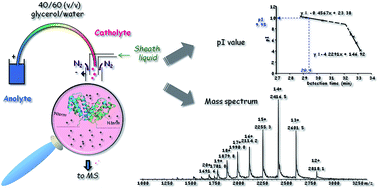On-line capillary isoelectric focusing hyphenated to native electrospray ionization mass spectrometry for the characterization of interferon-γ and variants
Abstract
The on-line hyphenation of Capillary IsoElectric Focusing (CIEF) with ElectroSpray Ionization Mass Spectrometry (ESI/MS) has been carried out in a non-denaturing detection mode at the CIEF-MS interface. This CIEF-MS coupling methodology relied on the use of 40% glycerol–water medium as anti-convective agent in the CE capillary and the addition of 10 mM ammonium acetate buffer, pH 5, as a volatile aqueous sheath liquid. These CIEF-MS coupling conditions allowed the characterization of the highly basic cytokine human interferon-gamma (IFN-γ) and its detection as a non-covalent homodimer (33 814.3 g mol−1) corresponding to the active form of this immune-regulatory protein. An experimental pI value of 9.95 was determined for the human IFN-γ homodimer in these conditions. The CIEF-MS analysis of several variants bearing punctual or deletion mutations within the two D1 and D2 basic clusters at the C-terminal end of IFN-γ revealed the different contribution of these domains to the charge properties of this heparan sulfate-binding protein.


 Please wait while we load your content...
Please wait while we load your content...